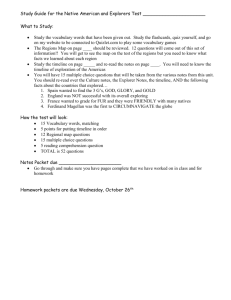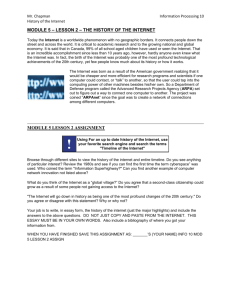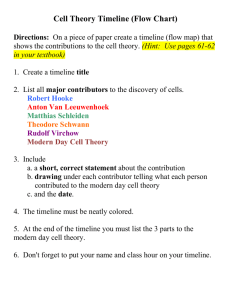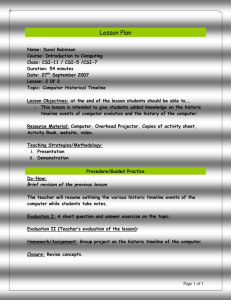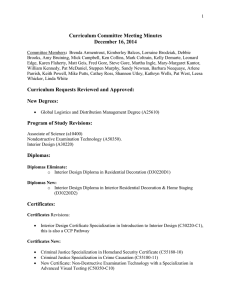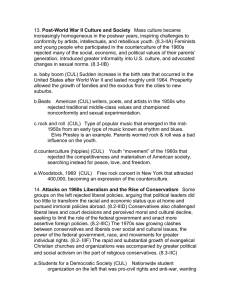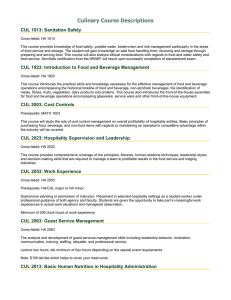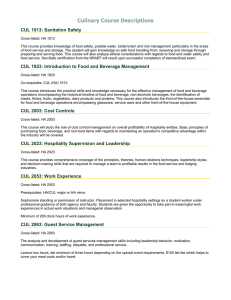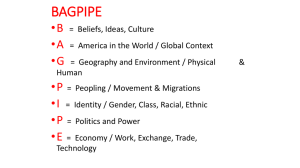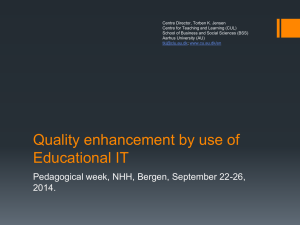Timeline: Ideas, Beliefs, and Culture
advertisement
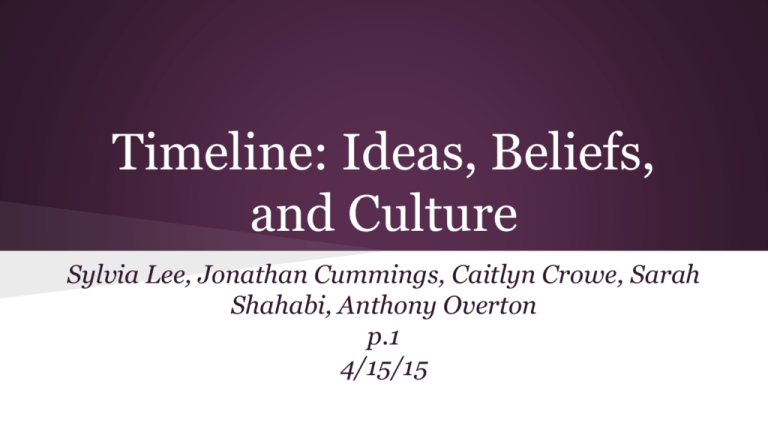
Timeline: Ideas, Beliefs, and Culture Sylvia Lee, Jonathan Cummings, Caitlyn Crowe, Sarah Shahabi, Anthony Overton p.1 4/15/15 CUL - 1 Compare the cultural values and attitudes to different European, African American, and native peoples in the colonial period and explain how contact affected intergroup relationships and conflicts Event Timeline ● 1607 - Jamestown, Virginia is founded. European contact with Native Americans, and later Africans, racial superiority ● Establishment of restoration colonies, tak even more land. S. Carolina, Tobacco, need slave labor ● 1680 Pueblo Revolt (Pope”s Rebellion) rebellion against spanish conquistadors. ● 1754 French and Indian War. French settlers needed good relations with indigenous for fur trade, Native Americans sided with French ● 1763 Pontiac’s Rebellion, don’t want to give up more land. Paxton Boys - slaughter of natives. seen as heros Key Terms ● Triangular Trade - The system of trade between the New World of America, Europe, and Africa o Mainly crops and raw materials were shipped from the New World to Europe, o Manufactured goods were sent from Europe into the New World and Africa o Slaves were shipped from Africa into the Caribbean where they eventually entered the Americas ● Slavery - When one human owned another for labor/ Indentured Servitude - When colonists would work under a farm owner for several years to “pay” for their trip to America o Slavery overtook popularity opposed to servitude, this helped foster the racist attitude that will be held against blacks for many more years CUL - 2 Analyze how emerging conceptions of national identity and democratic ideals shaped value systems, gender roles, and cultural movements in the late 18th century and 19th century Event Timeline ● 1803 The Louisiana Purchase made many colonist decided to move West and discover new land during this time. Instead of urban living quarters with market places, individuals had to fend and hunt for themselves ● 1825 Hudson River School of art was founded, influenced by European Romantics, paintings were largely landscapes ● 1835 -1850Irish and German immigrants settled in the North West. The Potato Famine led to mass starvation in Ireland and about 1 million Irish settlers settled in the north west. German immigrants wanted to escape political repressions after the failed revolution of 1848. Key Terms ● “Republican Motherhood” - Called on women to teach their children republican values, granting them a new importance in American culture ● “ Cult of Domesticity” - insisted that women keep a proper Christian home separate from the male sphere of politics and business. CUL - 3 Explain how cultural values and artistic expression changed in response to the Civil War and the post war industrialization of the United States Event Timeline ● 1863 - Emancipation Proclamation Lincoln's declaration that slaves “are, and henceforward shall be free” o Led to the changing mindset that blacks were equal to whites and deserved the same opportunities and rights as whites o This moral belief was not held in many Southern states but rather that blacks are inferior. This belief will hold strongly in many southern regions for MANY years to come Key Terms ● Gilded Age - This term was coined by Mark Twain labeling the new industrialism and booming industry, despite that the majority of the wealth was in the hands of the few ● Reconstruction - The effort of the federal government to rebuild and reform the South after losing the Civil War. o Many southerners rejected this help, still distrustful of federal government and northerners ● Scabs - workers brought in by companies to work if their workers were on strike, usually African Americans or immigrants. ● “Gospel of Wealth”, “Acres of Diamonds” must work to be wealthy ● Realism - depict life, dirty, realistic, urban scenes because of rise of industrial cities CUL - 4 Analyze how changing religious ideals, Enlightenment beliefs, and republican thought shaped the politics, culture, and society of the colonial era through the early republic Event Timeline ● 1720-1740 The first great Awakening sparked emotional religious revival ● 1776 John Locke’s ideals expressed in his work Two treatise of Government heavily influenced the creation and the content of the Declaration of Independance. ● 1776 Thomas Paine's Common Sense was published. Paine’s arguments rely heavily on emotional appeal and his writing came out as intensely passionate ● 1790-1820 The Second Great Awakening again brought a revamping to strong religious revivalism which came up largely to contrast the beliefs of deism and Enlightenment rationale Key Terms ● Enlightenment- 1700’s movement that focused on reason. Belief that human reason was the solution to nearly all problems, emotion was somewhat rejected by these ideals ● Deism- A belief that God had created the universe but does not actively intervene, such as a watchmaker to a clock CUL - 5 Analyze ways that philosophical, moral, and scientific ideas were used to defend and challenge the dominant economic and social order in the 19th and 20th centuries Event Timeline ● Early to Mid 19th Century The New Frontier lured young, working class men away from the east coast. The upper class saw no reason to go westward since they were already successful. New class division. ● Mid 19th Century Transcendentalists disrupted the social order. Inspired by Romanticism and focused on the individual -discovering the innerself by trusting intuition. ● 1860’s+ Republican party- immediate emancipation and moderates (free soilers) Democrats- critical of Lincoln, supported civil war ● Early 20th Century Coming off of such economic and political upheaval, radicals discover socialism ● WWI, WWII disrupt the social order spark feminist movements and economic booms in post war years Key Terms ● Panic of 1837 - Banknotes lost value, land sales plummeted, credit tightened, depression. Foreign and domestic causes: Gold and silver pulled from US by England, Coinage Act of 1834 ● Temperance - abstinence from alcoholic drink ● McCarthyism- making accusations of treason based on the fear of communism. Originating from the second red scare in the 1950’s. ● Executive Order 9066 - Japanese internment. 1942 “relocation” ● Watergate Scandal - 1972 “dirty tricks” campaign by the Committee to Reelect the President (CRP) ● Glasnost and perestroika - openness and reform from old cold war habits. Mikhail Gorbachev. CUL - 6 Analyze the role of Culture and the arts in 19th and 20th century movements for social and political change Event Timeline ● 1852 Uncle Tom’s Cabin by Harriet Beecher Stowe increased northern support for abolition, fueled the start of the Civil War and eventually the Emancipation Proclaimation ● 1906 Pure Food and Drug Act. The Jungle by Upton Sinclair pushed legislators to pass consumer protection laws after the horrors of the meat-packing industry were revealed ● 1920 The 18th Amendment outlawed the sale, manufacture and transportation of alcohol went into effect as a result of pressure from “drys”. Linked alcohol with corruption, temperance for moral reasons ● 1950’s Civil Rights sparked by Jackie Robinson, new push resulted in Brown v. Board of Education ruling Key Terms ● Muckrakers Sensationalists that focused on exposing corruption CUL - 7 Explain how and why “modern” cultural values and popular culture have grown since the early 20th century and how they have affected American politics and society Event Timeline ● 1920’s increasing consumerism starting in the 1920’s ● 1970 Clean Air Act, result of push by environmentalists. Silent Spring ● 1974 Public loses faith and trust in government in light of the Watergate scandal. Become wary of government involvement and regulation, more conservative ● 1980’s An increased emphasis on religion and conservatism in society, push against abortion rights and ERA. Key Terms ● Jazz/Rock n’ Roll/Pop - the evolution of popular music of the younger generations throughout the 1900’s ● New Left - liberal party, composed of young people , focused mostly on exiting the war in Vietnam. ● Equal Rights Amendment - Grant women equal wages, equal standing as men under the law (not in society). Shot down in 1982
